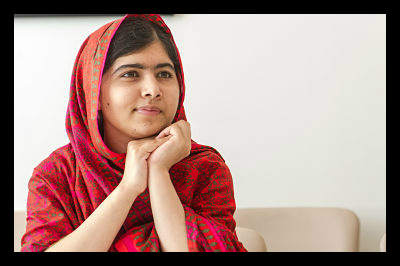Malala Wins Nobel Peace Prize

By the age of 17, if a teenager has secured a part-time job, a driver’s license and takes home a good report card, they typically feel pretty accomplished. But 17-year-old Malala Yousafzai has already experienced and accomplished more than most do in a lifetime. On October 10, she added another accomplishment to her list: the youngest person to ever receive the Nobel Peace Prize.
Yousafzai was awarded the Nobel Peace Prize along with Kailash Satyarthi, “for their struggle against oppression of young people and children and children’s right to education,” Chairman of the Norwegian Nobel Committee Thorbjorn Jagland said.
To get to this monumental point in her life, Yousafzai has been through incomprehensible trials, including threats against her life. But through it all, this young girl has been a beacon to the girls in undeveloped countries, in particular Pakistan.
Yousafzai’s story began in 2009, when the young girl took to a blog to transcribe her thoughts and feelings of the world around her, in her native home of Swat Valley in northwestern Pakistan. The Taliban announced an edict that no girls were to be educated. Yousafzai, whose father is a schoolteacher, knew the value of education and chose to attend school, even after the edict was issued.
While journaling her days online, Yousafzai started to receive death threats from the Taliban. On Oct. 9, 2012, the threats came to life.
CNN reported of her attack, “[Gunmen] halted the van…demanded the other girls in the vehicle to identify her…she was pointed out. At least one gunman opened fire, wounding three girls.” The two girls survived the shooting and Malala sustained shots to the head and neck.
Malala underwent a surgery to remove the bullets, and doctors had to remove a part of her skull to reduce brain swelling. She was eventually taken to Queen Elizabeth’s Hospital in the U.K. via helicopter. This young girl who fought for her right to be educated now was fighting to recover from what could have been life-ending injuries. After close to three months, Malala was released from the hospital to rehabilitate in her family’s new home.
Word spread globally of the young heroine, resulting in the United Nations creating a global education campaign entitled, “I am Malala,” even proclaiming November 10 to be Malala Day, focusing on “’Malala and the 32 million girls like Malala not in school.”
Yousafzai recovered from her wounds and returned to school at Edgbaston High School for Girls in Birmingham, England. Since the ordeal, she has become a light for girls all over the world.
Yousafzai has created the Malala Fund, which focuses on educating girls in Pakistan, Kenya, Nigeria and the girls who are Syrian refugees in Jordan. She has also published a book entitled “I am Malala.”
This advocate for education and most recent recipient of the Nobel Peace Prize still has work cut out for her. A CNN infographic from 2012 showed over 4.5 million girls are still out of school in Pakistan.
Even though the statistic is staggering, Yousafzai’s influence can be seen in young girls in her home country. Ahmad Shah, who was an aide to Yousafzai’s father and an educator himself, asked a young girl what she wanted to be when she grew up. Her reply? “I want to become Malala Yousafzai to work for education and peace,” Shah recalled.
The world has its eyes on Malala Yousafzai for now and for the foreseeable future because she is sure to change the world, one little girl at a time.
– Kori Withers
Sources: CNN, CNN 2, The Washington Post, Nobel Prize
Photo: Flickr
